What is Precipitated Calcium Carbonate Used for?
What is Precipitated Calcium Carbonate Used for?
Calcium carbonates have long been recognized as useful additives for thermoplastics and particularly in PVC for many applications. Ground calcium carbonate (GCC) is generally used as a filler with an interesting ratio performance/price.
Precipitated Calcium Carbonate (PCC), however, exhibits a much smaller particle size. It is much more than a filler. The specific structure and granulometry of PCC allow it to fulfill additional functions, such as:
- Processing aid
- Impact modification (reinforcer)
- Weather-resistant Agent
Thus, PCC is one of a unique class of additives which can be classified as being multi-functional providing the end-user with an outstanding cost/performance opportunity. Its regular & controlled crystalline shape and ultrafine particle size together with the hydrophobic surface coating, combine to benefit both polymer processing and subsequent physical properties.
PCC is a versatile additive for use in a wide range of plastic and elastomeric applications.
Now, let’s start by understanding how precipitated calcium carbonate (PCC) is different from ground calcium carbonate (GCC).
Basics of Precipitated Calcium Carbonate (PCC)
Basics of Precipitated Calcium Carbonate (PCC)
Calcium carbonate in the form of chalk, whiting, and limestone is perhaps the most widely available and utilized mineral additive in the world today. Processed to be available in a wide range of particle sizes, calcium carbonate functions as low-cost fillers added to extend and cheapen the widest range of polymeric systems.
In comparison to this, synthetic PCCs offer a range of technical benefits beyond the capability of GCC fillers and other more expensive and sophisticated additives. Ultrafine coated precipitated calcium carbonates (CPCC) are characterized by five important attributes as mentioned below:
-
Primary particle size (20-70 nanometres)
-
Regularity of shape
-
Narrowness of particle size distribution
-
Surface coating of calcium stearate
-
High purity
How PCC is Different from GCC
The combination of the above-mentioned properties clearly differentiates CPCC from GCC fillers, and is also a factor in explaining the performance benefits that are observed during the use of the precipitated calcium carbonate in rigid PVC.
The figure below compares the granulometry between ground and precipitated calcium carbonate:


Granulometry Between Ground (1 micron) Left and Precipitated Calcium Carbonate (70 nm) Right
The manufacture of synthetic calcium carbonate by the reaction of gaseous carbon dioxide with a colloidal suspension of calcium hydroxide is sufficiently versatile to produce different morphologies. Distinctive and reliable reaction control criteria exist for the manufacture of PCC where morphology and crystalline size can be varied at will.
Production of Precipitated Calcium Carbonate
Precipitated calcium carbonate is produced using the most economic process existing today.
- Limestone is converted into calcium oxide and carbon dioxide by means of calcination at temperatures above 900°C. To ensure a high level of purity, the calcination process is carried out using natural gas.
- After the calcined lime has been slaked with water, the resulting milk of lime is purified and carbonated with the carbon dioxide obtained from the calcination process (See reactions below).
 Precipitated Calcium Carbonate Production
Precipitated Calcium Carbonate Production
-
Total carbonation step results in a suspension of CaCO.
- The suspension is then filtered to obtain a cake comprising 40% - 60% solid matter (depending on particle diameter). This filter cake is then dried and subsequently deagglomerated in grinders.
Ultrafine PCC grades are reacted with fatty acids prior to filtration i.e. when still in the suspension stage. The fineness of the grain, as well as the crystal form (aragonite, calcite), is controlled by factors, such as:
- Temperature
- Concentration of reactants
- Time
Depending on the chemical composition of the milk of lime used and on the purifying stages during production, both technical, as well as foodstuff and pharmaceutical grades, can be produced.
 Purification Stages of PCC
Purification Stages of PCC
Crystallinities of Precipitated Calcium Carbonate
 The manufacture of synthetic calcium carbonate by the reaction of gaseous carbon dioxide with a colloidal suspension of calcium hydroxide is sufficiently versatile to produce a number of different morphologies
The manufacture of synthetic calcium carbonate by the reaction of gaseous carbon dioxide with a colloidal suspension of calcium hydroxide is sufficiently versatile to produce a number of different morphologies
Surface coating agents are often incorporated and fatty acids are widely used. These are compatible and bond to the filler surface as the calcium salts. The coating cannot be removed by solvent extraction clearly indicating that it is bonded to the calcium carbonate surface.
Distinctive and reliable reaction control criteria exist for the manufacture of PCC where morphology and crystalline size can be varied at will.
The calcitic trigonal rhombohedral crystal variants are those most commonly used in PVC compounding. The wide range of chemical, physical and industrial applications areas for CPCC products are defined by:
- The ultimate nature of the primary particles
- The presence of the fatty acid coating.
- The aggregate strength and dispersibility.
- The optimum surface coating distribution.
The ability to exert control over the above individual elements to gain the balance of properties required.
The table below summarizes the different crystallinity, properties and applications.
|
|
Fine PCC
|
Ultrafine PCC (PCC or CPCC)
|
|
Typical crystal shapes
|
Scalenohedral calcite, Aragonite
|
Rhombohedral calcite
|
|
Mean particle diameter by air permeability
|
0.2-0.4
|
0.02-0.10
|
| Specific surface by BET, (m2/g)
|
14-6
|
70-18
|
|
Coating content, (%)
|
|
1.9-3.3
|
|
Fields of application
|
Paper, paints
|
Plastics, plastisols, sealants, inks
|
Precipitated Calcium Carbonate as a Processing Aid
Precipitated Calcium Carbonate as a Processing Aid
When ultrafine CPCC is compounded into rigid PVC several quite specific effects are observed, as mentioned below.
-
Shorter fusion/gelation time
- Elimination of plate out
- Melt extensibility
- Increased output
-
Improved surface finish and gloss. and elimination of surface defects, i.e. sharkskin which occurs under conditions of high shear gradients, such as those seen in injection molding operations
#1 Gelation Time
The degree of gelation is a measure of the breakdown of the PVC grain structure and its transformation into a homogeneous matrix. Under gelling or over gelling can result in poor physical properties of PVC. CPCC, because of its very small particle size and surface coating, generates fast and efficient fusion in PVC formulations.
Comparison of Brabender (a fusion test) traces for a series of PVC mixes shows a fusion behavior for the CPCC containing mix having an almost identical trace to the traditional process aid. The GCC system has a markedly different profile (see figure
below).
 Comparison of Brabender (a fusion test) traces for a series of PVC mixes
Comparison of Brabender (a fusion test) traces for a series of PVC mixes
The reason for this behavior is the compatibility of the CPCC primary particle size at ~70nm with the PVC primary particle. This compatibility allows good contact to develop which is instrumental in developing frictional heat. Because of the large number of CPCC particles present, this effect is distributed evenly throughout the PVC matrix resulting in more efficient heat up and ultimate fusion of the PVC granules, hence the earlier gelation.
Electron micrograph studies of a series of dry blends based on both CPCC and a typical GCC clearly illustrate this point also (See table below).
|
Dry blend with CPCC
|
Dry blend with GCC
|
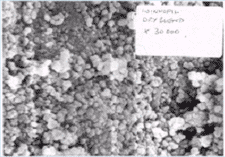
|
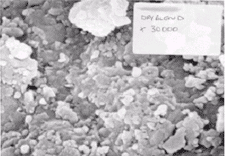
|
- Easy wetting/dispersion of CPCC through fatty acid surface treatment.
- Good compatibility during PVC compounding due to regular ultrafine particle size.
- More homogeneous dry blend for processing.
- Better heat transfer/frictional benefits.
|
-
Particle size is very different from CPCC system.
-
Clear presence of larger fragments of fillers.
-
Dry blending efficiency is lower.
-
Less homogeneous and limited contribution to fusion behavior vs. CPCC.
|
CPCC / GCC Comparison on Dry Blending Behavior with PVC Primary Particles
#2 Plate Out Elimination
Plate out is a phenomenon sometimes observed during extrusion processes that have its origins in varying degrees of incompatibility within the formulation itself. This can involve lubricants and other additives used. The addition of acrylic processing aids is known to improve this situation as a result of the:
- Enhanced fusion
- Improved compound compatibility that is promoted
Due to the ultrafine particle size of precipitated calcium carbonate and its ability to improve the state of dispersion of all the components present in such compounds, resistance to plate out is seen to improve when CPCC is included in these formulations. As a result of this, running times can be extended without the need for costly delays in production for cleaning.
#3 Melt Extensibility
The resistance of a PVC melt to the applied shear forces during the various processing conditions is a critical property for the polymer compound during its processing experience. This is particularly true for injection molding processes where the high shear gradients seen can give rise to surface defects which in some cases can be unacceptable and cause components to be rejected.
Again conventional processing aids are often incorporated to improve the melt properties but also often can increase the melt viscosity and affect output potential.
Benefits in Injection Molding
CPCC containing molding compounds demonstrate excellent processing behavior and produce components with high gloss without the need for conventional processing aids (see also surface finish). GCCs fail to match this performance even when used in combination with processing aid.
The table below illustrates the reformulation trends possible to optimize processing aid in molding compounds.
|
Formulation With
Processing Aid + GCC
|
Typical Alternative
CPCC Formulation
|
| PVC |
10 |
100 |
| Stabilizer |
2 |
2 |
| Processing Aid |
2 |
0 |
| 1µ GCC |
3 |
- |
| CPCC |
- |
5 |
The CPCC Formulation Represents a Significant Cost Saving and Improved Surface Finish and Lower Reject Rates.

Troubleshooting Rigid PVC Molding Defects: Solve Splay, Blush, Peel
Benefits in Rigid PVC Foam
The use of CPCC in rigid PVC foam formulations allows the development of a more regular and uniform cell structure (see figure below).
- This property is derived from the beneficial improvement in melt reinforcement that accompanies the incorporation of these ultrafine calcium carbonates.
- Melt elasticity and elongation are improved which allows optimization in the use of other additives necessary for successful foam production.
There has been speculation as to whether CPCC can act as a "nucleating agent" due to its very small particle size. This has yet to be confirmed although, in theory, this would be an expected outcome of their use.
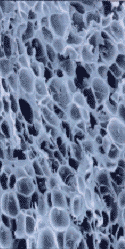
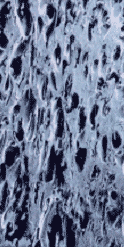
With CPCC (L), Without CPCC (R)
#4 Increased Output
It is often desirable to maximize the production output but this can also be limited by the speed of gelation of a PVC compound.
While combinations of processing aids can be used in order to assist the fusion characteristics of a particular compound, precipitated calcium carbonate will allow high production output rates without the need for such high usage of processing aids. This is of specific interest for larger output machinery where a suitable level of gelation has often been a limiting factor for high output.
#5 Surface Finish
CPCC containing compounds exhibit excellent gloss in extrusion and injection molding applications. In pigmented rigid PVC, CPCC gives an unparalleled degree of gloss because of its:
- Ultrafine particle size
- Absence of the large particles present in ground fillers that produce surface defects thereby increasing light reflection
Materials sometimes difficult to process such as CPVC (chlorinated polyvinyl chloride) are made more manageable if CPCC is included in the formulation.
The figure below clearly shows the smooth surface finish of the CPCC formulation compared to that with ground calcium carbonate.
The relatively large particles of the latter cause surface defects which increase light scattering.
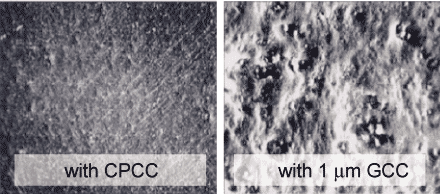 Surface Finish of CPCC vs GCC
Surface Finish of CPCC vs GCC
Precipitated Calcium Carbonate as a Reinforcer
Precipitated Calcium Carbonate as a Reinforcer
The decisive advantage which results from the incorporation of ultrafine precipitated calcium carbonate in rigid PVC formulations relates to the significant improvement in the impact performance. This improvement is seen in rigid PVC compounds without the addition of any organic impact modifier.
In the presence of both acrylic and CPE-type modifiers, this improvement in the impact properties is repeated from the levels seen with the modifier alone. Whereas polymer-modified compounds can display a sharp decrease in impact strength at low temperatures, the CPCC modified system possesses residual impact resistance even at low temperatures (see figure below).
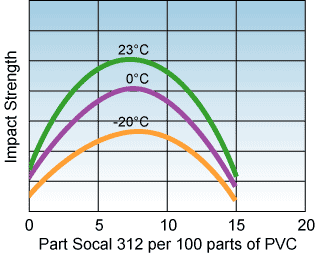 Mean Height of Fall h50 of Roller Blind Profiles as a Function
Mean Height of Fall h50 of Roller Blind Profiles as a Function
of Socal® 312 Content at Varying Test Temperatures
In contrast to organic impact modifiers, precipitated calcium carbonate increases the:
- e-modulus of the extruded component
- impact strength without reducing the rigidity
The explanation of this positive behavior can be found in both the processing improvements that synthetic calcium carbonate provides along with its ability to improve the dispersibility of other components of the formulation i.e. organic impact modifiers. This improved dispersion and processing benefit also results in the reduction in the % reversion observed for the extrusion of a typical window profile formulation (see table below).
|
Formulation
|
% Reversion
|
Rate
m/min
|
Single V Notch
Charpy impact at 23°C
(kJ/m2)
|
|
TOP
|
BOTTOM
|
| Ground filler system
|
1.87
|
2.02
|
1.1
|
14.0
|
|
Precipitated CC
|
1.57
|
1.67
|
1.1
|
Hinge Break
|
The more complete gelation that results from the inclusion of precipitated calcium carbonate provides a matrix that in comparison to natural calcium carbonates has fewer defect sites and opportunities for a crack propagation process leading to reduced mechanical properties.
The micrographs show the differences in failure mode for PVC containing precipitated calcium carbonate from those containing a natural calcium carbonate derived by milling (see figure
below). It is possible to obtain ductile failures with reduced impact modifier levels by using precipitated calcium carbonate.
 Differences in Failure Mode for PVC Containing PCC vs GCC
Differences in Failure Mode for PVC Containing PCC vs GCC
View all Precipitated calcium carbonate grades used as impact modifiers or reinforcers here»
PCC as a Weathering-resistant Agent
PCC as a Weathering-resistant Agent
The resistance of unplasticized PVC to degradation due to exposure to the elements depends on several different factors. These include:
- The nature of the stabilization system
- The pigmentation used
- The grade of PVC
- Other additives in the formulation
It is clear that all these formulation ingredients have a role to play.
Rigid PVC formulations that contain synthetic precipitated calcium carbonate show excellent color durability and retention of mechanical properties in particular impact strength. This positive effect on weatherability is due to a number of different factors some of which have their origin in the improvements in dispersion and processing behavior seen when precipitated calcium carbonate is included in exterior formulations.
The chemical nature and purity of the calcium carbonate is also a factor as is the much-enhanced surface finish.
CPCC in rigid PVC has a positive effect on weathering by:
- A more effective compounding of the PVC ensures that the stabilizers present are dispersed in a homogenous way. The presence of CPCC in the formulation removes the need to overwork the PVC which itself provides a more stable polymer.
- The ultrafine nature of the synthetic calcium carbonates acts as an efficient radical trap for any evolved HCl thereby inhibiting dehydrochlorination giving reduced yellowing.
(see figure below)
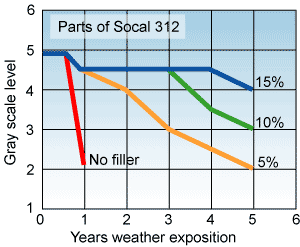 Weather Proofness of a Brown, Lead-stabilized Rigid PVC Section
Containing Different Levels
Weather Proofness of a Brown, Lead-stabilized Rigid PVC Section
Containing Different Levels
of Filling Materials (Exposition Area: Rheinberg/Germany)
- The enhanced surface finish and gloss are major factors in the surface resistance to degradation. (see table below)
|
Ground Calcium Carbonate
|
Precipitated Calcium Carbonate
|
|
Mag X 250
Before Weathering
|
Mag X 250
Before Weathering
|
|
Mag X 250
After 8GJ/m2
Weathering Xeon 1200
|
Mag X 250
After 8GJ/m2
Weathering Xeon 1200
|
Effect of Weathering on PVC Surface Containing Ground Calcium Carbonate and Precipitated Calcium Carbonate
Find Suitable Precipitated Calcium Carbonate Grades
View a wide range of precipitated calcium carbonate grades available in the market today, analyze technical data of each product, get technical assistance or request samples.